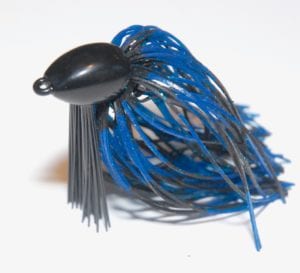Various Styles Available for Bass Fishing
No matter what body of water a bass fisherman fishes; it is almost a guarantee that a jig will be rigged on one of their rods. The jig is a versatile lure and has been morphed into many designs; here is a look at the different styles of jigs available.
Swim Jigs – When fishing around vegetation, a great lure is a swim jig. The key component of a swim jig is a bend in the hook eye that is around 30 degrees. This allows the jig to swim through the vegetation and not get hung up. A balanced head is important because you do not want it to roll when being retrieved; this destroys the natural appeal it has. The weedguard is another important component of the swim jig. You do need nor want the heavy weedguards that come on a standard flipping jig, so it is important to look at the weedguard and make sure it isn’t too stout.
Flipping Jigs – from flipping stumps, or along a weed edge, a flipping jig is a great choice when targeting bass that have positioned themselves tight to cover. From changing the size of your jig and varying what your trailer is, a jig is a very versatile choice for bass anglers to use on any body of water. Two styles of flipping jigs include the Arkie style, which was one of the first bass jig designs on the market and is very popular when targeting shallow water cover, such as boat docks and laydowns, since its head design has a flat spot that can be skipped along the water with ease. The other is a Grass jig, which may have a recessed line tie this way it can slide through the dense vegetation and not get hung up. A very stout hook is needed here, as flipping in the heavy mats requires a heavy action rod and 60 plus pound braided line, so a light wire hook would bend.

Finesse Jigs – The round, ball headed finesse jig is a staple lure for bass anglers during the spring, when bass are pre spawn or spawning around chunk rock or gravel. This light wire hook jig has a unique skirt that flares up around the head of the jig.
Football Jigs – Dragging the bottom with a jig is a very productive technique during the summer months, when bass are relating to ledges, points and humps. Keeping the jighead in contact with the bottom and crawling it over rocks, gravel or along sand is achieved easier by using a football head jig. Use the smallest weight jig possible, while still being able to keep in contact with the bottom.
Swimbait Jigs – A soft plastic swimbait can be rigged on a jighead in several situations, from fishing it in open water situations, such as underwater points, humps, flats or sand drops. Like a swim jig, the eye and angle of the hook, allow the jighead to be swum with ease through the water and helps it not roll, thus giving it a natural presentation in the water.
The size of your jighead will be dictated by the depth of water you are fishing and what depth the bass are sitting at. Each jighead has some form of a plastic keeper on it, be sure to rig your swimbait straight, so the complete package swims straight in the water.

















